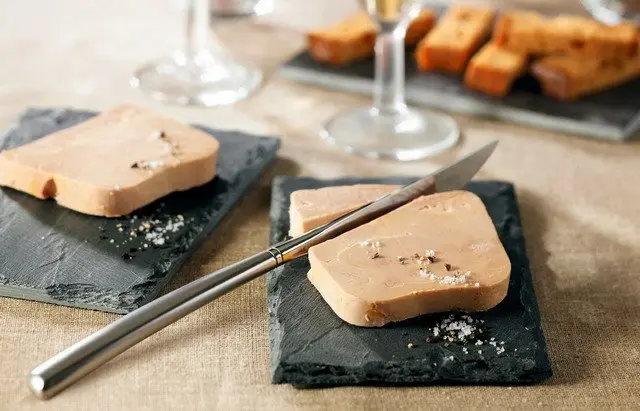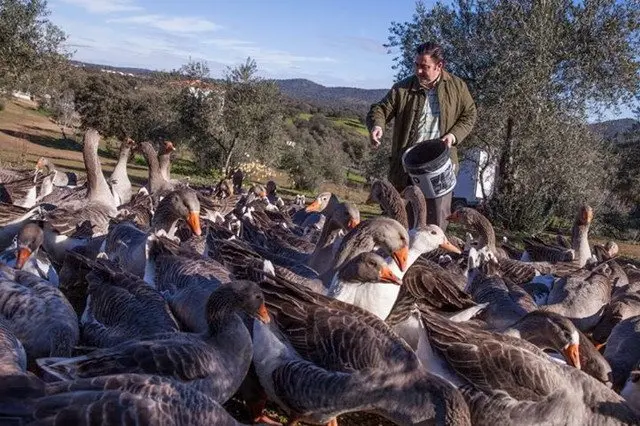Foie gras without force-feeding: it can be done
49 K 4.4/5 (20 reviews)
Last modified on: December 15th 2014
Foie gras without force-feeding: it can be done

I adore foie gras...
I willingly admit it, I adore foie gras: the texture, the taste, the festive aspect – I enjoy all of it. I really love eating it, preparing it and, most of all, sharing what I have made with my family over Christmas and New Year.
...but then I begin to have doubts
Of course, when I unwrap my raw foie gras to prepare it, I have no illusions. I know that in order to get this lovely foie gras, the duck or goose has been force fed (the process known as “gavage” in French) and that it is hardly ethical.
It is easy to say, but I do have a problem with this force-feeding, so I try to do everything I can to lessen its impact by buying only the best quality livers possible, of certified origin, the French “Label Rouge” (red label) in particular, and now we are starting to see the way animals have been reared stated on the label. I try, as far as possible, to avoid the industrial-style battery farms in which such dreadful scenes have been photographed by hidden cameras.
I am just salving my conscience, you might say and, of course, you would be right, making out that it is cruel but inevitable.
I already knew that, left to their own devices, geese will gorge themselves at the start of winter, eating more than usual to build up their reserves. This is the process accentuated by gavage, a process that dates back to the Ancient Egyptians, who learned it from the Hebrews.

Eduardo and his geese
That is as far as I had got until I heard recently (thanks, Alison) about Eduardo Sousa.

Eduardo is a Spanish farmer who rears geese in Estremadura, Spain. His geese live in semi-liberty and eat what the farm produces or has growing naturally: acorns, olives, grain, seeds, etc.
On his farm, he produces a natural foie gras from these geese, without force-feeding, relying simply on their propensity to eat more as winter approaches. At this time, the geese are given as much as they want to eat.
So, the idea is incredibly simple: before the winter cold arrives, just feed the geese as much food as they want and they will stuff themselves quite happily (I'm not sure that “stuff” is quite the appropriate term here, but still…). The liver swells and, after slaughter, this can be made into foie gras.
Of course, this method doesn't produce the huge livers of conventional gavage; they are smaller (200-250g as opposed to 400g on average), but have a better flavour, apparently. As the geese are not eating maize, their livers are – or, rather, were – greyish. This did not affect the flavour, but was less appealing to the eye. To compensate, Eduardo planted yellow lupins and, after eating these, his geese now produce livers with the sought-after delicate yellow colour.
And that is not all that comes with Eduardo's production method: to make foie gras, you need goose liver, salt and pepper, then you cook it, that is all – with no alcohol or spices added.

So what does this method do for the flavour? Impossible for me to say, as I have not (yet?) tasted it, but when you know that in 2006, Eduardo won the much-coveted “Coup de Coeur” (favourite) prize at the Salon International de l'Alimentation, Paris (Global Food Marketplace), making it de facto the best foie gras in the world, that tells you something.
Note that French producers were particularly peeved, trying to argue that this wasn't “proper” foie gras because of the weight.
Dan Barber, an American chef, who has given a TED talk about Eduardo, talks about how incredible the taste is: he was aware of aromas and flavours that would be logical if this or that spice had been added, yet this is not the case. He tells of how he was ready to bet that it contained aniseed; he could taste this distinctly, but no.
Can I try some?
From what I have found online, it appears that this is almost impossible to get hold of. All of it is bought up, even well in advance, by the very, very rich (Emirs from the Gulf, the White house, etc.).
But there is hope: Eduardo has started working with a Frenchman, Diego Labourdette, to produce foie gras by the same method in the south-west of France. We will not be seeing it supermarkets yet, of course, but at least we will be able to order some…

A few links:
Eduardo's own farm website: www.lapateria.eu
Website of the joint farm with Diego Labourdette: sousa-labourdette.com
Dan Barber's TED talk: A Foie Gras Parable
Lasts posts
Butter vs. grease
We often read in a recipe where a pastry is put into a mould that, just before pouring, the mould should be buttered or greased. But what's the difference between these 2 terms?December 1st 20255785
Getting out of the fridge early
Very often when you're cooking, you need to take food or preparations out of the fridge, to use them in the recipe in progress. There's nothing tricky about this: you just take them out of the fridge and use them, usually immediately, in the recipe. But is this really a good method?November 24th 20259285
Who's making the croissants?
When you look at a bakery from the outside, you naturally think that in the bakery, the bakers make the bread, and in the laboratory, the pastry chefs make the cakes. It's very often like that, with each of these professions having quite different ways of working, but sometimes there's also one...November 23th 2025832
Oven height
When we put a dish or cake in the oven, we naturally tend to put it on the middle shelf, and that's what we usually do. But in some cases, this position and height can be a little tricky, so let's find out why.October 8th 20252,4215
The importance of sieving
In recipes that use a fine powder (flour, powdered sugar, etc.), you'll often see the advice to sift before using it. To sift is to pass the powder in question through a sieve (a very fine strainer) before incorporating it into your recipe. It's often advice, but is it really useful?September 3rd 20257,3163
Other pages you may also like
The window-pane test in bread-making
The home bread-makers often ask themselves “Have I kneaded my dough long enough?” . A good question, as dough that is insufficiently kneaded will not rise properly or will fall flat when the top is slashed, which is very frustrating. To know when the dough is ready, one can rely on the length...June 16th 202196 K 23.9
Candied fruits: don't get ripped off
Do you like candied fruit? You might like to nibble a handful or add it to a recipe, like a classic fruit cake or delicious Italian specialities like panettone or sicilian epiphany pie.June 21th 201767 K 24.2
Is it really necessary to cream egg yolks?
Let’s try and answer a question that crops up in cookery and patisserie, even if it verges on the existential: do the egg yolks in a custard recipe really need to be beaten until pale, or not?February 28th 201844 K4.3
Butter doesn't make you fat, unless you eat too much of it.
Whenever I'm discussing cooking and recipes, there is one idea which comes up frequently, like this: "Oh no! But that's got butter in it" (I should add, for the sake of accuracy, that this is something I hear more frequently from women, who are almost all concerned with keeping their figure). ...March 26th 201245 K4.5
Steam for baking bread
What does steam have to do with bread-making? This is not only a bakers' secret, it is something you might not think of at all: if you make bread and bake it like a cake, you will end up with bread, but pale and with a thick, hard crust – a long way from the golden-brown crusty loaf you had in...June 16th 2021146 K4.5
Post a comment or question
Follow this page
If you are interested in this page, you can "follow" it, by entering your email address here. You will then receive a notification immediately each time the page is modified or a new comment is added. Please note that you will need to confirm this following.
Note: We'll never share your e-mail address with anyone else.
Alternatively: you can subscribe to the mailing list of cooling-ez.com , you will receive a e-mail for each new recipe published on the site.









